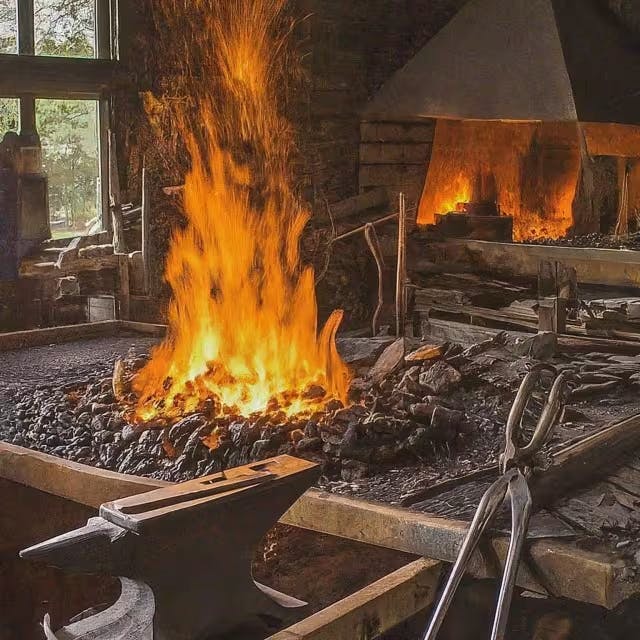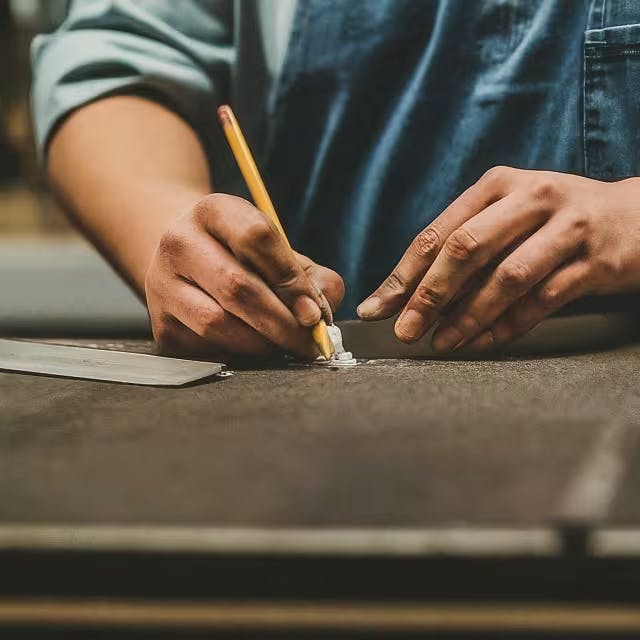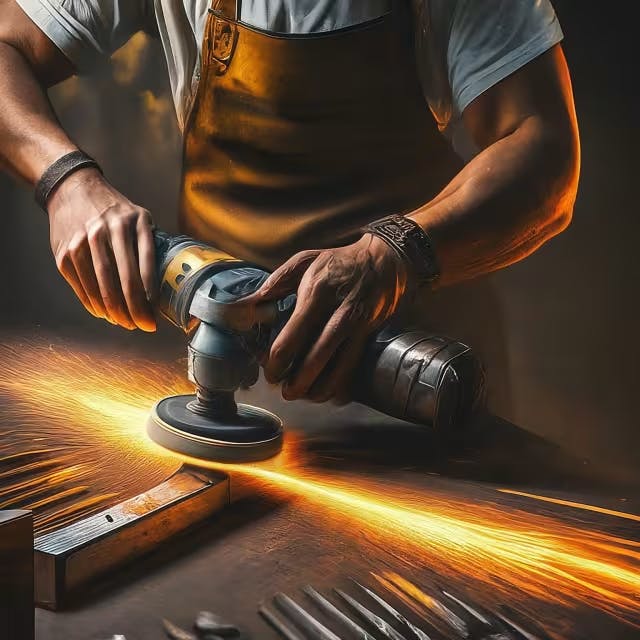Blacksmith's Craft: Essential Techniques
Abana Chapter
March 14, 2024

Discover the ancient and skilled profession of the blacksmith, a master of transforming wrought iron or steel into functional and decorative items through the art of hammering, heating, and shaping. The Blacksmith's Craft: Essential Techniques delves into the heart of blacksmithing, exploring the critical role of the forge, the nuanced hammering methods for metal shaping, and the sophisticated process of quenching. Whether you're intrigued by the traditional methods that have forged tools and gates for centuries or the modern adaptations that continue to innovate, this guide offers a thorough exploration into the essential techniques every aspiring blacksmith and curious reader should know.
Key Takeaways
The forge is central to blacksmithing, functioning as the primary tool for heating metal to make it malleable for shaping.
Skilled hammering techniques are crucial for effectively shaping metal into desired forms.
Quenching is a sophisticated process that involves cooling down metal workpieces in water or oil to achieve desired hardness and durability.
Precision in measuring and cutting metal is essential for crafting items that meet specific requirements and dimensions.
The finishing phase, which includes grinding and polishing, is key to giving metal craftwork a professional and aesthetically pleasing appearance.

Understanding the Blacksmith's Forge
Delving into the realm of blacksmithing reveals the heart of this ancient craft: the forge. A forge is where raw metal transforms into beautiful, functional pieces through the application of intense heat. Whether you're a budding blacksmith or simply fascinated by the craft, understanding how a forge operates is key.
For those interested in traditional methods, coal forges offer a link to the past, while modern blacksmiths may lean towards the efficiency and control provided by gas forges. Each type has its advantages, with coal forges providing a certain authenticity and gas forges offering precise temperature control.
Blacksmithing projects start with heating metal in the forge until it reaches a malleable state. The color of the metal often indicates its temperature, ranging from red to white hot. This visual cue is crucial for timing the forging process correctly. Once the metal is heated, it's transferred to an anvil where it can be hammered, bent, and shaped into the desired form.
Choosing the right anvil is just as essential as selecting a forge. Durability, size, and material are all factors to consider. For those looking for guidance, exploring options like Kanca anvils or Atlas anvils can provide a starting point.
In this journey, feedback and learning are crucial. For instance, a project aiming to replicate traditional blacksmithing tools digitally received advice on rendering techniques for a more realistic appearance, suggesting that constant refinement is part of the blacksmith's evolution (source). This blend of tradition and innovation mirrors the blacksmith's continuous quest for perfection.
Blacksmithing is a blend of art and science, requiring both creativity and technical skill. The forge is where this magic begins, making understanding its operation and nuances an essential step for anyone interested in the craft.
Hammering Techniques for Shaping Metal
Mastering the art of metal shaping requires a deep understanding of various hammering techniques, each designed to manipulate metal with precision and intention. One foundational method is drawing out, which lengthens the metal by hammering it evenly, a technique pivotal for creating slender, elongated shapes. This skill hinges on controlled, consistent strikes, ensuring the metal stretches without thinning too much in one area.
Discovering the right hammer for different tasks is crucial. Different types of hammers, such as rounding hammers, are essential for specific techniques, influencing the efficiency and outcome of your work.
Another essential technique is upsetting, the opposite of drawing out. This process thickens the metal at a particular point, requiring the smith to hammer the end of the workpiece back onto itself. It’s a technique that demands precision to prevent the metal from buckling.
Further, the art of bending is accomplished through a combination of hammering and leverage, often utilizing the horn of the anvil. This technique allows the blacksmith to curve or angle the metal into desired shapes, integral for creating hooks, loops, and various decorative elements.
Lastly, punching and drifting are critical for creating holes and enlarging them without cutting through the metal. These techniques not only require a firm hammering hand but also a delicate touch to maintain the integrity of the material around the hole.
For those looking to deepen their understanding of these techniques, exploring resources like "Selecting the Right Hammer for Metal Forging" offers insights into choosing the best tools for each task. The journey of mastering hammering techniques in the blacksmith's craft is ongoing, blending tradition with personal flair to achieve metalwork that's as functional as it is beautiful.
The Art of Quenching: Cooling Down Your Creations
Quenching, a pivotal stage in blacksmithing, involves cooling hot metal quickly to harden it. The choice of quenching medium—oil, water, or brine—depends on the metal type and the desired properties of the final product. Oil cools slower than water, offering a less severe quench which is suitable for steel with high carbon content, reducing the risk of cracking. Water, on the other hand, is often used for iron or low-carbon steel, providing a swift cool down. Understanding the nuances of quenching mediums is essential for achieving the ideal hardness without compromising the metal's integrity. For individuals delving deeper into metal shaping techniques, exploring tools like swages and fullers provides a comprehensive understanding of their role in blacksmithing.
The quenching process not only impacts the metal's physical properties but also its internal structure. Careful consideration must be given to the metal's temperature prior to quenching; overheating can lead to undesirable outcomes such as warping or cracking. After quenching, the metal often undergoes tempering, a heat treatment that decreases brittleness while maintaining the hardness achieved through quenching.
For artisans and hobbyists interested in exploring this craft further, insights into creating detailed and durable metalwork can be gained through learning about forming swages for anvil hardy techniques. This knowledge enhances one's ability to manipulate metal with precision, opening up new avenues for creativity and innovation in the realm of blacksmithing.

Crafting with Precision: Measuring and Cutting Metal
When delving into the precision-driven world of blacksmithing, accurate measurements and precise cuts are non-negotiable. A slight deviation can dramatically alter the final product, underscoring the importance of precision in every step. Real-world challenges, as highlighted in a recent article, reveal that tasks such as measuring and marking, though seemingly straightforward, are riddled with potential errors.
To combat inaccuracies, always measure twice before making any cuts. This simple practice can halve the likelihood of mistakes, ensuring your metal pieces align perfectly with your project's specifications. Additionally, selecting the right tools for the job is crucial. Explore top-notch measuring tools designed for metalworking, like those featured in an article on reliable tape measures, to ensure you're equipped with the best.
Moreover, understanding the material you're working with and how it responds to different cutting techniques can make a significant difference. Whether it's a laser cutter for intricate designs or a traditional chisel for more robust work, each tool has its place. Leveraging advanced technologies can further enhance precision and efficiency, as discussed in a piece on advanced metalworking tools.
Remember, the mark of a skilled blacksmith lies not only in their ability to shape metal but also in their meticulous preparation and precise execution of these foundational steps. With the right approach and tools, you can minimize errors, save time, and elevate the quality of your craftsmanship to new heights.

Finishing Touches: Grinding and Polishing Metal Craftwork
For achieving a truly professional finish on any metal craftwork, grinding and polishing stand out as crucial steps. These methods not only enhance the appearance but also significantly improve the durability of metal items by removing imperfections and creating a protective surface. Here's a brief overview:
Grinding: This process involves the removal of excess material or smoothing out rough surfaces using abrasive tools. For beginners and seasoned blacksmiths alike, selecting the right grinding tools is vital for efficiency and safety. Explore top belt sanders for metal shaping and finishing, and ensure you choose the appropriate size, power, and abrasive type for your project.
Polishing: After grinding, polishing gives the metal its shine and desired finish. This step uses finer abrasives compared to grinding and often requires different tools. Polishing not only enhances the aesthetic appeal but also provides a certain level of corrosion resistance to the metal.
Understanding the differences and applications of various abrasives for metal finishing is key to achieving the best results. Additionally, using the right grinders, buffers, and accessories not only makes the job easier but also ensures a higher quality finish.
Remember, patience and practice play a significant role in mastering these techniques. Begin with simpler projects to build your skills before moving on to more complex pieces. With the right approach and tools, you can elevate your metal craftwork to professional standards. Mastering the essential techniques of blacksmith's craft ensures that the age-old tradition of shaping metal into both functional items and artistic pieces thrives in the modern era. By combining the precise art of heating, hammering, bending, and quenching with meticulous measuring and finishing processes, craftsmen can create durable and aesthetically pleasing metalwork. Thus, understanding and applying these foundational skills is crucial for anyone looking to excel in the blacksmithing craft, showcasing a perfect blend of historical technique and contemporary innovation.
Frequently Asked Questions
What are the differences between coal and gas forges in blacksmithing?
Coal forges offer a traditional forging experience, emitting more smoke and requiring constant management to maintain temperature. Gas forges, on the other hand, provide cleaner operations with precise temperature control, making them more beginner-friendly. The choice between the two often comes down to the desired authenticity of the forging process versus convenience and control over the working environment.
How can the color of heated metal guide the blacksmithing process?
The color of heated metal serves as a guide for blacksmiths by indicating the metal's temperature, which determines its malleability. As metals heat, they transition through colors from red to white-hot. These visual cues enable blacksmiths to time the forging process correctly, ensuring the metal is worked at the ideal temperature for shaping, hammering, and bending into the desired form.
What factors should be considered when choosing the right anvil?
When choosing the right anvil, consider its durability, size, and material, as these factors impact its performance and suitability for your projects. Durability ensures it can withstand repetitive hammering, size must match the scale of work you intend to do, and the material affects its lifespan and effectiveness in shaping metal. Exploring specific models, such as Kanca or Atlas anvils, can provide a practical starting point for finding an anvil that meets your needs.
What are some essential hammering techniques in blacksmith's craft?
In blacksmithing, mastering various hammering techniques is crucial for manipulating metal effectively. Key techniques include drawing out to elongate the metal, upsetting to thicken it, bending using hammering and leverage, and punching and drifting to create and enlarge holes without cutting the metal. Each technique requires precision and a deep understanding of how to apply the right amount of force and direction to achieve the desired shape or form in the metal.
How does quenching medium affect the final properties of metal?
The quenching medium directly influences the metal's final hardness, ductility, and the potential for cracking. For instance, oil provides a slower cooling process ideal for high carbon steel, reducing cracking risks, while water and brine cool more rapidly, suited for iron or low-carbon steel but with a higher likelihood of inducing stress fractures. Each medium affects the metal's internal structure differently, crucially impacting its performance and applications.
What role does precision play in measuring and cutting for blacksmithing projects?
Precision in measuring and cutting is foundational in blacksmithing, impacting the project's success from start to finish. Accurate measurements ensure that forged pieces fit intended designs precisely, avoiding costly and time-consuming revisions. Precise cutting, on the other hand, influences the quality and aesthetics of the final product, enabling intricate designs and seamless joinery. Without a high degree of precision throughout these processes, achieving both functional and visually appealing metalwork becomes challenging.
Why are grinding and polishing important in metal finishing?
Grinding and polishing are critical in metal finishing for several reasons: they remove excess material and imperfections, smooth out rough surfaces to improve durability, and enhance the metal's appearance by adding shine and desired finish. Not only do these processes contribute to the aesthetic appeal of the metalwork, but they also provide a layer of corrosion resistance, increasing the longevity of the finished product.


